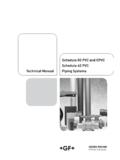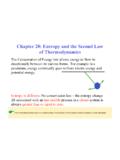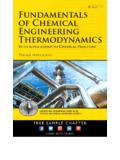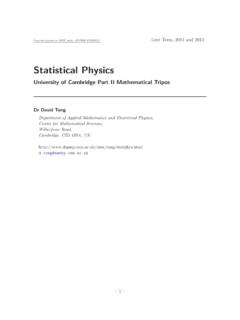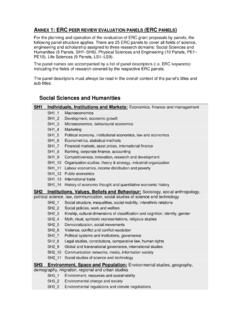Transcription of Schedule 80 PVC and CPVC Schedule 40 PVC Technical …
1 Schedule 80 PVC and CPVC Schedule 40 PVCP iping SystemsTechnical Manual3 Table of ContentsIntroduction: PVC and CPVC Piping Systems ..4 Product Summary ..4 Material Data ..5-6 Engineering Data ..7 Pressure Ratings ..7-9 Water Hammer ..9-11 Temperature Pressure Relationship ..12 Thermal Expansion and Contraction .. 13-17 Friction Loss Characteristics ..18-21 Installation Instructions ..22 Storage and Handling ..22 Solvent Welding ..22-27 Threading ..28-29 Flanging ..30 Above Ground Installation ..31-33 Below Ground Installation ..34-36 Standards ..37 ASTM ..37-38 ASME/ANSI ..38 NSF/ANSI ..38 Specifications ..39-41 IPS Socket Dimensions ..42 Weld Lines in Molded Fittings ..43 Useful Charts and Conversions .. 44-46 4 Introduction: PVC and CPVC Piping SystemsProduct SummaryThermoplastics PVC (Polyvinyl Chloride) and CPVC (Chlorinated Polyvinyl Chloride) are light, flexible, tough and provide exceptional corrosion resistance.
2 Because of these and other properties of a high quality engineered thermo-plastic, the savings that can be realized in initial installation and continuing maintenance costs are can handle temperatures up to 140 F (60 C). CPVC handles temperatures up to 210 F (99 C).Chemical ResistancePVC and CPVC thermoplastics are highly resistant to acids, alkalis, alcohols and many other corrosive materials. Both materials are ideal for process piping installation and most service piping applica-tions. For details, please consult our Chemical Resistance Chart or contact your local sales Free ServicePVC and CPVC thermoplastics will not rust, scale, pit or corrode, nor are they subject to electroly-sis. You are assured many years of leak-free, maintenance-free service. For buried applications, PVC and CPVC are not affected by soil conditions or galvanic is not required for indoor non-exposed installations.
3 For outdoor installation where the piping may be exposed to significant sunlight, we recommend painting; two coats of a white or light-colored, water-base, outdoor latex paint provides added Installed CostBoth PVC and CPVC have installed costs substantially lower than steel alloys or lined steel and are usually more competitive than carbon steel. Solvent cemented connections contribute to this lower installed cost while the much lighter weight (about one-sixth as much as steel) speeds and simplifies handling during : Versatility and DependabilityPVC and CPVC fittings, pipe and valves have been found suitable for more than 50% of the corrosive and non-cor-rosive applications within the Chemical Process Industries. Vinyl piping systems have been sold into industrial applications for over 50 years. The establishment of strong industry standards and specifications, plus a third party certification through NSF, provides the specifying engineer, contractor and end user with a tested and accepted piping system to solve their corrosion DataPhysical Properties of Rigid PVC and CPVC Thermoplastic MaterialsThe following table lists typical physical properties of PVC and CPVC thermoplastic may exist depending on specific compounds and TestSpecific Gravity.
4 02D-792 Tensile Strength @ 73 FPSI7,2008,000 Same in Circumferential DirectionD-638 Modules of Elasticity Tensile @ 73 FPSI430,000360,000 Ratio of Stress on Bent Sample at FailureD-638 Compressive Strength @ 73 FPSI9,50010,100D-695 Flexural Strength @ 73 FPSI13,00015,100 Tensile Stress/Strain on Bent Sample at FailureD-790 Izod Impact @ 73 FFt-Lbs/In of Resistance of a Notched Sample to a Sharp BlowD-256 Relative Hardness @ 73 FDurometer D Rockwell R 80 3 110-120 119 Equivalent to Aluminum D-2240 D-785 ThermodynamicsPropertiesUnitPVCCPVCR emarksASTM TestCoefficient of Thermal Linear Expansion per Fin/in/ x x 10-5D-696 Thermal Conductivity BTU/hr/ft2/ Specific Heat of 0-100 CC-177 Specific Heat CAL/g/ Ratio of Thermal Capacity to that of Water at 15 CMaximum Operating Temperature F140210 Pressure Rating is Directly Related to TemperatureHeat Distortion Temperature @ 264 PSI F158217 Thermal Vibration and Softening OccursD-648 Decomposition Point F400+400+Scorching by Carbonization and DehydrochlorationFlammabilityPropertiesU nitPVCCPVCR emarksTest MethodAverage Time of Burningsec.
5 <5<5D-635 Average Extent of Burningmm<10<10 Flame Spread Index<10<10E-162 Flame Spread10-254-18E-84 Flash Ignition F730 900 D-1929 Smoke Developed*1000285 Flammability (.062 )V-OV-O, 5VB 5 VAUL-94 Softening Starts, approx. F250295 Material Become Viscous F350395 Material Carbonizes F425450 Limiting Oxygen Index (LOI)Vol. %4360D-2863 6 Note: This data is based on information supplied by the raw material manufacturers. It should be used as a general recommendation only and not as a guarantee of performance or longevity. The determination of the suitability of any material for a specific application is the responsibility of the end TestWater Absorption%+ + @ 73 F + @ 212 FWeight Gain in 24 HoursD-570 Poisson s Ratio @ 73 Cell Classification12454-B23447-BD-1784 Industry Standard ColorDark Gray/ WhiteMedium GrayNSF Potable Water ApprovedYesYes7 Engineering DataIn the engineering of thermoplastic piping systems, it is necessary to have not only a working knowledge of piping design but also an awareness of a number of the unique properties of addition to chemical resistance, important factors to be considered in designing piping systems employing thermoplastics are1.
6 Pressure ratings2. Water hammer3. Temperature-Pressure relationships4. Thermal expansion and contraction5. Friction-loss characteristicsThese factors are considered in detail in this RatingDetermining pressure-stress pipe relationshipsISO Equation: The pressure rating of a pipe is deter-mined by the circumferential stress which results from internal pressure. The relationship between internal pressure, circumferential stress, wall thickness, and diameter is governed by an ISO equation. In various forms this equation is:Long-Term Strength: To determine the long-term strength of thermoplastic pipe, lengths of pipe are capped at both ends (see Fig. 1-C) and subjected to various internal pressures, to produce circumferential stresses that will produce failure within 10 to 10,000 hours. The test is run according to ASTM D 1598 Standard Test for Time Hydrostatic Pressure. The resulting failure points are used in a statistical analysis (outlined in ASTM D 2837) to determine the Where: P = Internal Pressure, psi S = Circumferential Stress, psi t = Wall Thickness, in.
7 DO = Outside Pipe Diameter, in. R = DO/tP = 2S = 2St 2S = (DO)-1 R-1 DO-t P t2S = R - 1 S = P (R-1) P 2 Long-Term Strength Test per ASTM D-1598 Regression Curve Stress/Time-to-Failure for PVC Type 1 Pipe test specimen per ASTM D-1598 for Time-to-Failure of Plastic Pipe Under Long-Term Hydrostatic Pressure characteristic regression curve that represents the stress/time-to-failure relationship for the particular thermoplastic pipe compound under test. This curve is represented by the equation: The regression curve may be plotted on a log-log paper, as shown in the Regression Curve figure below, and extrapolated from 10,000 to 100,000 hours ( years). The stress at 100,000 hours is known as the Long Term Hydrostatic Strength (LTHS) for that particular thermo-plastic compound. From this (LTHS) the Hydrostatic Design Stress (HDS) is determined by applying the service factor multiplier, as shown on page T = a + b log SWhere:a and b are constants describing the slope and intercept of the curve, and T and S are time-to-failure and stress, 1-C 8 Service Factor: The Hydrostatic Stress Committee of the Plastics Pipe Institute (PPI) has determined that a service (design) factor of one-half the Hydrostatic De-sign Basis would provide an adequate safety margin for use with water to ensure useful plastic-pipe service for a long period of time.
8 While not stated in the standards, it is generally understood within the industry that this service life is a minimum of 50 , the standards for plastic pipe, using the service factor, required that the pressure rating of the pipe be based upon this Hydrostatic Design Stress, again calculated with the ISO equation. While early experience indicated that this service factor, or multiplier, of provided adequate safety for many if not most uses, some experts felt that a more conserva-tive service factor of would better compensate for water hammer pressure surges, as well as for slight manufacturing variations and damage suffered during installation. The PPI has issued a statement recommending this service factor. This is equivalent to recommending that the pressure rating of the pipe should equal times the system design pressure for any particular instal-lation. Based upon this calculation, many thousands of miles of thermoplastic pipe have been installed in the United States without failure.
9 It is best to consider the actual surge conditions, as outlined later in this section. In addition, reductions in working pressure should be considered when handling aggressive chemical solutions and in high-temperature service. Numerical relationships for service factors and design stresses of PVC and CPVC are shown in the table below. Service Factors and Hydrostatic Design Stress (HDS)*(Hydrostatic Design Basis equal 4000 psi) ( MPa) Service FactorHDS psi ( MPa) psi (11 MPa)*Material: PVC Type I & CPVCM aximum Pressures: The pressure ratings of thermo-plastic pipe represent the maximum allowable operat-ing pressure within a piping system for water at 73 F ( C) based upon a service factor of Pressure Rating for Schedule 80 PVC/CPVC Pipe at 73 FSizePSI Bar Pressures Collapse RatingThermoplastic pipe is frequently specified for situations where uniform external pressures are applied to the pipe, such as underwater applications.
10 In these appli-cations, the collapse rating of the pipe determines the maximum permissible pressure differential between external and internal pressures. The basic formulas for collapsing external pressure applied uniformly to a long pipe are:1. For thick wall pipe where collapse is caused by elastic instability of the pipe wall:Pc = (DO2 - Di2) 2DO22. For thin wall pipe where collapse is caused by elastic instability of the pipe wall:Pc = 2cE ( t )3 1-v2 DmWhere: Pc = Collapse Pressure (external minus internal pressure), psi = Compressive Strength, psi v = Poisson s Ratio E = Modulus of Elasticity, psi DO = Outside Pipe Diameter, in. Dm = Mean Pipe Diameter, in. Di = Inside Pipe Diameter, in. t = Wall Thickness, in. c = Out of Roundness Factor, Approximately result is a high momentary pressure surge called water hammer.
